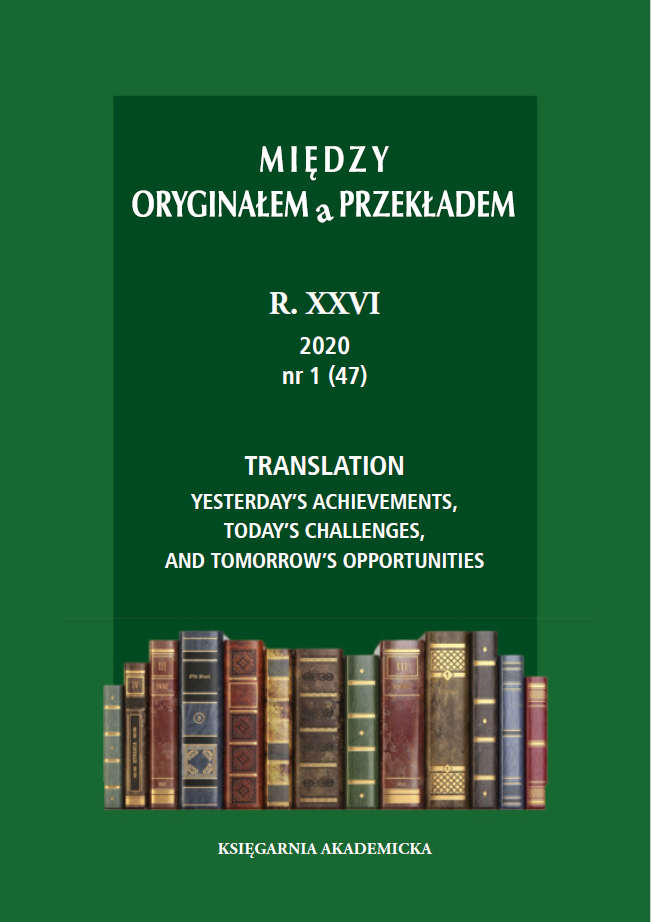The Translator in the Spotlight
Personal Remarks in Translators’ Footnotes
DOI:
https://doi.org/10.12797/MOaP.26.2020.47.01Keywords:
footnotes, invisibility, literary translation, paratext, translator’s powerAbstract
It is often said that the translator ought to remain in the shadow of the author and limit themselves to enabling successful and undisturbed communication between author and reader. The translator is not allowed to add their own voice to a literary work. However, it turns out they actually do. The aim of the article is to examine unconventional footnotes where the translator overtly speaks with their own voice. First, a few examples of literary works making interesting use of footnotes are presented. The similarities among the translators’ footnotes are highlighted, with a special focus on the issue of the translator’s power. Then, particular categories of translators’ footnotes are discussed, wherein translators express their opinions, show their emotional involvement or share stories from their private lives. It turns out that the footnote becomes a unique channel of direct communication between the translator and the reader, sometimes even involving competition with the author. A question is asked as to what may possibly encourage translators to assert their presence in the text in this way.
Downloads
References
Frużyńska, J. (2012), Mapy, encyklopedie, fraktale. Hipertekstowe opowieści w prozie XX wieku, Wydział Polonistyki Uniwersytetu Warszawskiego, Warszawa.
Henry, J. (2000), “De l’érudition à l’échec: la note du traducteur”, Meta. Journal des traducteurs/Meta. Translators’ Journal, 45(2), pp. 228-240, https://doi.org/10.7202/003059ar. DOI: https://doi.org/10.7202/003059ar
Krajewska, M. (2017), Oswoić słowo. Komentarze w północnych książkach Mariusza Wilka i ich rosyjskich przekładach, Wydawnictwo Naukowe UMK, Toruń.
Nida, E. (1975), Language, Structure, and Translation: Essays, Stanford University Press, Stanford.
Nord, C. (2007), “Function Plus Loyalty: Ethics in Professional Translation”, Génesis. Revista Científica do ISAG, 6, pp. 7-17.
Paprocka, N. (2009), “Przypisy tłumacza/redakcji w przekładach prasy (na przykładzie tłumaczeń w «Forum»)”, in: E. Skibińska (ed.), Przypisy tłumacza, Księgarnia Akademicka, Wrocław–Kraków, pp. 175-198.
Skibińska, E. (2009), “O przypisach tłumacza: wprowadzenie do lektury”, in: E. Skibińska (ed.), Przypisy tłumacza, Księgarnia Akademicka, Wrocław–Kraków, pp. 7-22.
Sztorc, W. (2016). “Przypisy tłumacza w świetle teorii literatury hipertekstowej”, Między Oryginałem a Przekładem, 22(32), pp. 121-134, https://doi.org/10.12797/MOaP.22.2016.32.09. DOI: https://doi.org/10.12797/MOaP.22.2016.32.09
Sztorc, W. (2019a). “Jak powstaje przekład? Przypisy dotyczące warsztatu tłumacza”, in: Przestrzenie przekładu 3, Wydawnictwo Uniwersytetu Śląskiego, Katowice, in print.
Sztorc, W. (2019b). “Rozmowy między wierszami – interakcje tłumacza z autorem w przypisach (i innych paratekstach) do tekstów literackich”, Między Oryginałem a Przekładem, 25(43), pp. 29-46, https://doi.org/10.12797/MOaP.25.2019.43.02. DOI: https://doi.org/10.12797/MOaP.25.2019.43.02
Tomicka, M. (2009), “Przypisy tłumacza w polskim przekładzie Le Dictionnaire des idées reçues Gustawa Flauberta”, in: E. Skibińska (ed.), Przypisy tłumacza, Księgarnia Akademicka, Wrocław–Kraków, pp. 215-228.
Ziarkowska, J. (2009), “Objaśnianie odległej współczesności. Informacje o nowym świecie w przypisach tłumaczy serii Proza Iberoamerykańska”, in: E. Skibińska (ed.), Przypisy tłumacza, Księgarnia Akademicka, Wrocław–Kraków pp. 89-112.
Downloads
Published
Issue
Section
License

This work is licensed under a Creative Commons Attribution-NonCommercial-NoDerivatives 4.0 International License.






